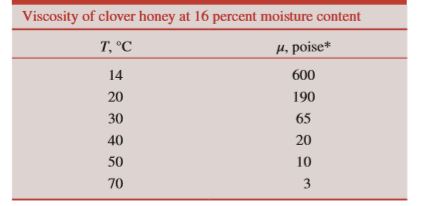
Elements Of Electromagnetics
7th Edition
ISBN: 9780190698614
Author: Sadiku, Matthew N. O.
Publisher: Oxford University Press
expand_more
expand_more
format_list_bulleted
Question
The viscosity of clover honey is listed as a function of temperature. The specific gravity of the honey is about 1.42 and is not a strong function of temperature. The honey is squeezed through a small hole of diameter D = 6.0 mm in the lid of an inverted honey jar. The room and the honey are at T = 20°C. Estimate the maximum speed of the honey through the hole such that the flow can be approximated as creeping flow. (Assume that Re must be less than 0.1 for the creeping flow approximation to be appropriate.) Repeat your calculation if the temperature is 50°C. Discuss.

Transcribed Image Text:Viscosity of clover honey at 16 percent moisture content
T, °C
H. poise*
14
600
20
190
30
65
40
20
50
10
70
3
Expert Solution
This question has been solved!
Explore an expertly crafted, step-by-step solution for a thorough understanding of key concepts.
This is a popular solution
Trending nowThis is a popular solution!
Step by stepSolved in 4 steps with 8 images

Knowledge Booster
Learn more about
Need a deep-dive on the concept behind this application? Look no further. Learn more about this topic, mechanical-engineering and related others by exploring similar questions and additional content below.Similar questions
- The block of weight W = 50 N is pulled by a weight W0 = 60 N along the surface of a table by means of an inextensible cable and a pulley. Between the block and the table there is a uniform layer of oil of viscosity m = 0.1 Pa-s and clearance h = 2 mm. The contact area is 0.01 m2. Find the terminal velocity U if the table is very long.arrow_forward(a) A wing section with a chord of c and a span of b is mounted at zero angle of attack in a wind tunnel. A pitot probe is used to measure the velocity profile in the viscous region downstream of the wing section as shown in the figure. The measured velocity profile is u(z) = U∞ - (U/2) cos[TZ/(2w)] for -w ≤ z ≤w. Here, w = 0.02c. Assuming a constant pressure p = po along the streamlines (dashed lines in the figure) and across the wake where the velocity was measured, calculate the friction drag coefficient Cp, of the wing section. U Streamlines u = U_ -- cos 22 2W² +w Viscous wake = -W (b) Consider a thin flat plate at zero angle of attack in an airflow at P∞ = 1.225 kg/m³, T∞ = 288 K and μ∞ 1.7894 x 10-5 kg/m/s. The length of the plate is 2 m and the span is 0.5 m. Assume the boundary layers on the plate are laminar throughout (on the upper and lower surfaces both) where LBL(x)/x = 0.664/√√/Rex applies. The freestream velocity is 100 m/s. Calculate the friction drag (Df) of the first…arrow_forwardOil Coating: A long, continuous belt is pulled upwards through a chemical oil bath at velocity V0. The belt has rectangular cross-section and has length (L), width into the paper (W). The belt picks up a film of oil of thickness h, density ρ, and dynamic viscosity μ. Gravity g tends to make the oil drain down, but the movement of the belt keeps the fluid from running off completely. Assume fully developed, steady, laminar, incompressible and two-dimensional flow of oil to answer the following questions. Assume that no pressure gradient is needed in the vertical direction to drive the film flow. Also assume that the shear stress at the air-oil interface is zero (free shear condition). Assume no-slip condition for the fluid in contact with the moving belt. Justify any other assumptions you may make. Show all steps. (a) Derive an expression for the two-dimensional velocity field inside the oil film in terms of the known parameters. Clearly indicate your co-ordinates and origin. You must…arrow_forward
Recommended textbooks for you
 Elements Of ElectromagneticsMechanical EngineeringISBN:9780190698614Author:Sadiku, Matthew N. O.Publisher:Oxford University Press
Elements Of ElectromagneticsMechanical EngineeringISBN:9780190698614Author:Sadiku, Matthew N. O.Publisher:Oxford University Press Mechanics of Materials (10th Edition)Mechanical EngineeringISBN:9780134319650Author:Russell C. HibbelerPublisher:PEARSON
Mechanics of Materials (10th Edition)Mechanical EngineeringISBN:9780134319650Author:Russell C. HibbelerPublisher:PEARSON Thermodynamics: An Engineering ApproachMechanical EngineeringISBN:9781259822674Author:Yunus A. Cengel Dr., Michael A. BolesPublisher:McGraw-Hill Education
Thermodynamics: An Engineering ApproachMechanical EngineeringISBN:9781259822674Author:Yunus A. Cengel Dr., Michael A. BolesPublisher:McGraw-Hill Education Control Systems EngineeringMechanical EngineeringISBN:9781118170519Author:Norman S. NisePublisher:WILEY
Control Systems EngineeringMechanical EngineeringISBN:9781118170519Author:Norman S. NisePublisher:WILEY Mechanics of Materials (MindTap Course List)Mechanical EngineeringISBN:9781337093347Author:Barry J. Goodno, James M. GerePublisher:Cengage Learning
Mechanics of Materials (MindTap Course List)Mechanical EngineeringISBN:9781337093347Author:Barry J. Goodno, James M. GerePublisher:Cengage Learning Engineering Mechanics: StaticsMechanical EngineeringISBN:9781118807330Author:James L. Meriam, L. G. Kraige, J. N. BoltonPublisher:WILEY
Engineering Mechanics: StaticsMechanical EngineeringISBN:9781118807330Author:James L. Meriam, L. G. Kraige, J. N. BoltonPublisher:WILEY

Elements Of Electromagnetics
Mechanical Engineering
ISBN:9780190698614
Author:Sadiku, Matthew N. O.
Publisher:Oxford University Press

Mechanics of Materials (10th Edition)
Mechanical Engineering
ISBN:9780134319650
Author:Russell C. Hibbeler
Publisher:PEARSON

Thermodynamics: An Engineering Approach
Mechanical Engineering
ISBN:9781259822674
Author:Yunus A. Cengel Dr., Michael A. Boles
Publisher:McGraw-Hill Education

Control Systems Engineering
Mechanical Engineering
ISBN:9781118170519
Author:Norman S. Nise
Publisher:WILEY

Mechanics of Materials (MindTap Course List)
Mechanical Engineering
ISBN:9781337093347
Author:Barry J. Goodno, James M. Gere
Publisher:Cengage Learning

Engineering Mechanics: Statics
Mechanical Engineering
ISBN:9781118807330
Author:James L. Meriam, L. G. Kraige, J. N. Bolton
Publisher:WILEY